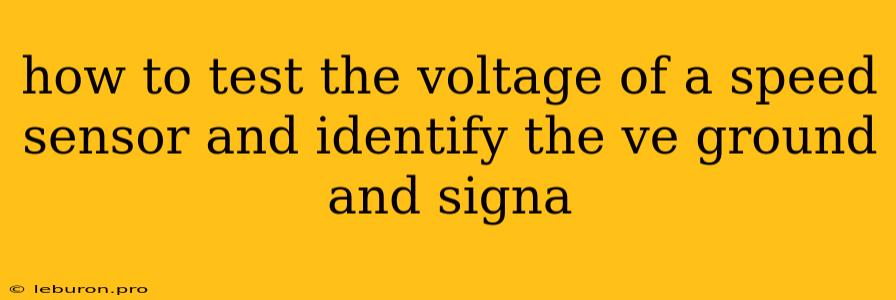How to Test a Speed Sensor Voltage and Identify the VE Ground and Signal
Speed sensors, also known as wheel speed sensors, play a crucial role in modern vehicles. They monitor the rotational speed of wheels, transmitting this data to the vehicle's electronic control unit (ECU) for a variety of functions. These functions include:
- Anti-lock Braking System (ABS): The ABS relies on wheel speed sensor data to determine the rate of wheel rotation and engage the system if necessary.
- Traction Control System (TCS): The TCS utilizes the sensor information to detect wheel slippage and distribute engine power accordingly to maintain traction.
- Electronic Stability Control (ESC): Similar to TCS, ESC employs wheel speed sensor data to detect vehicle instability and intervene to correct it.
- Vehicle Speedometer: The speedometer displays the vehicle's speed based on the information provided by the speed sensors.
However, issues with speed sensors can disrupt these essential functions. If you suspect a problem with your vehicle's speed sensor, testing its voltage and identifying the VE ground and signal wires is a critical step in troubleshooting.
Understanding the Speed Sensor
Speed sensors, typically magnetic sensors, work by generating a signal proportional to the speed of the rotating component they are monitoring. This signal is then transmitted to the ECU for processing.
Here's how they work:
- Magnetic Field: The sensor contains a magnetic field that is disrupted when a metal object (e.g., a toothed wheel or ring) passes through it.
- Signal Generation: As the toothed wheel rotates, the disruption of the magnetic field generates a series of pulses. The frequency of these pulses directly corresponds to the rotational speed.
- Signal Transmission: The sensor converts these pulses into an electrical signal, which is then transmitted to the ECU.
Testing the Speed Sensor Voltage
Tools Needed:
- Digital Multimeter (DMM): A DMM is essential for measuring voltage and resistance.
- Test Light: A test light can be helpful for identifying the VE ground wire.
- Vehicle Service Manual: The service manual will provide the necessary information for your specific vehicle, such as the location of the sensor and wiring diagrams.
Procedure:
- Locate the Speed Sensor: Refer to your vehicle's service manual to identify the location of the speed sensor. It is typically mounted near the wheel hub or transmission.
- Disconnect the Connector: Carefully disconnect the sensor connector to access the wires.
- Identify the Wires: Use a wiring diagram or a continuity test with your DMM to identify the VE ground, signal, and positive (+) wires. The VE ground wire is typically black or brown, while the signal wire is often a different color (e.g., white or blue).
- Connect the DMM: Set your DMM to the DC voltage range. Connect the positive (red) lead of the DMM to the positive (+) wire. Connect the negative (black) lead of the DMM to the VE ground wire.
- Test the Voltage: Rotate the wheel while observing the DMM reading. You should see a fluctuating voltage reading as the wheel rotates. The voltage range will vary depending on the vehicle, but it should be within a specific range (often between 0.5V and 5V).
Identifying the VE Ground and Signal Wire
Method 1: Using a Test Light
- Connect the Test Light: Connect the test light to the positive (+) wire of the speed sensor connector.
- Touch the Ground Wire: Touch the test light probe to each of the remaining wires in the connector. The wire that causes the test light to illuminate is the VE ground wire.
- Signal Wire Identification: The remaining wire is the signal wire.
Method 2: Using a DMM for Continuity
- Continuity Test: Set your DMM to the resistance or continuity test mode.
- Connect One Lead: Connect one lead of the DMM to the positive (+) wire.
- Check for Continuity: Touch the other lead to each of the remaining wires in the connector. The wire that shows continuity (a low resistance reading) is the VE ground wire.
- Signal Wire Identification: The remaining wire is the signal wire.
Interpreting the Test Results
Possible Scenarios:
- No Voltage Reading: If you get no voltage reading at all, it could indicate a faulty speed sensor, a broken wire, or a problem with the connector.
- Constant Voltage: If you get a constant voltage reading, it could indicate a faulty speed sensor that is not producing pulses or a short circuit in the wiring.
- Fluctuating Voltage: A fluctuating voltage reading is the expected outcome when the wheel is rotating. However, if the voltage range is outside the specified range for your vehicle, it could still indicate a problem with the sensor or wiring.
Troubleshooting Tips
- Check the Connector: Ensure that the connector is securely connected and free of corrosion or damage.
- Inspect the Wiring: Inspect the wiring for any breaks, short circuits, or signs of chafing.
- Clean the Sensor: If the sensor is dirty or corroded, clean it with a contact cleaner.
- Replace the Speed Sensor: If you've ruled out other possibilities, replacing the speed sensor is the most likely solution.
Note: Always follow safety precautions when working on electrical components in a vehicle. Disconnect the battery before performing any tests or repairs.
Conclusion
Testing the voltage of a speed sensor and identifying the VE ground and signal wires is an important step in diagnosing vehicle problems. By understanding the basic principles of speed sensor operation and using the methods outlined above, you can effectively diagnose and troubleshoot issues with your vehicle's speed sensors. Remember to consult your vehicle's service manual for specific information and always prioritize safety while working with electrical systems.
